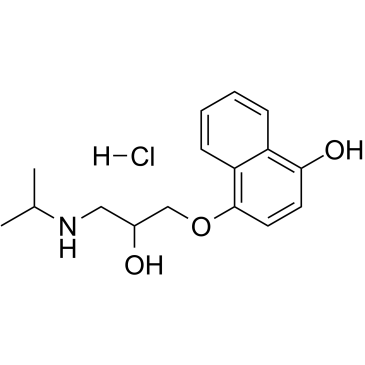4-hydroxy propranolol hcl

4-hydroxy propranolol hcl structure
|
Common Name | 4-hydroxy propranolol hcl | ||
|---|---|---|---|---|
| CAS Number | 14133-90-5 | Molecular Weight | 311.804 | |
| Density | 1.168g/cm3 | Boiling Point | 487.5ºC at 760mmHg | |
| Molecular Formula | C16H22ClNO3 | Melting Point | 156-158ºC | |
| MSDS | USA | Flash Point | 248.6ºC | |
Use of 4-hydroxy propranolol hcl4-Hydroxypropranolol hydrochlorid is an active metabolite of Propranolol. 4-Hydroxypropranolol hydrochlorid is of comparable potency to Propranolol. 4-Hydroxypropranolol hydrochlorid inhibits β1- and β2-adrenergic receptors with pA2 values of 8.24 and 8.26, respectively. 4-Hydroxypropranolol hydrochlorid has intrinsic sympathomimetic activity, membrane stabilizing activity and potent antioxidant properties[1][2][3]. |
| Name | rac-4-Hydroxy Propranolol Hydrochloride |
|---|---|
| Synonym | More Synonyms |
| Description | 4-Hydroxypropranolol hydrochlorid is an active metabolite of Propranolol. 4-Hydroxypropranolol hydrochlorid is of comparable potency to Propranolol. 4-Hydroxypropranolol hydrochlorid inhibits β1- and β2-adrenergic receptors with pA2 values of 8.24 and 8.26, respectively. 4-Hydroxypropranolol hydrochlorid has intrinsic sympathomimetic activity, membrane stabilizing activity and potent antioxidant properties[1][2][3]. |
|---|---|
| Related Catalog | |
| Target |
pA2: 8.24 (β1-adrenergic receptor) and 8.26 (β2-adrenergic receptor)[2] |
| References |
| Density | 1.168g/cm3 |
|---|---|
| Boiling Point | 487.5ºC at 760mmHg |
| Melting Point | 156-158ºC |
| Molecular Formula | C16H22ClNO3 |
| Molecular Weight | 311.804 |
| Flash Point | 248.6ºC |
| Exact Mass | 311.128815 |
| PSA | 61.72000 |
| LogP | 3.47600 |
| Storage condition | 2-8°C |
| RIDADR | NONH for all modes of transport |
|---|---|
| HS Code | 2922509090 |
| HS Code | 2922509090 |
|---|---|
| Summary | 2922509090. other amino-alcohol-phenols, amino-acid-phenols and other amino-compounds with oxygen function. VAT:17.0%. Tax rebate rate:13.0%. . MFN tariff:6.5%. General tariff:30.0% |
|
Stereoselective high-performance liquid chromatography determination of propranolol and 4-hydroxypropranolol in human plasma after pre-column derivatization.
J. Chromatogr. B. Biomed. Sci. Appl. 692(1) , 133-40, (1997) A stereoselective reversed-phase HPLC assay to quantify S-(-) and R-(+) enantiomers of propranolol and 4-hydroxypropranolol in human plasma was developed. The method involved liquid-liquid extraction ... |
|
|
Potential bias and mitigations when using stable isotope labeled parent drug as internal standard for LC–MS/MS quantitation of metabolites
J. Chromatogr. B. Analyt. Technol. Biomed. Life Sci. 878(31) , 3267-76, (2010) In recent years, increasing emphasis has been placed on quantitative characterization of drug metabolites for better insight into the correlation between metabolite exposure and toxicological observat... |
|
|
Potent antioxidant properties of 4-hydroxyl-propranolol.
J. Pharmacol. Exp. Ther. 308(1) , 85-90, (2004) The antioxidant properties of 4-HO-propranolol (4HOP), a major metabolite of propranolol, were studied and compared with that of propranolol and vitamin E (Trolox). When isolated hepatic microsomal me... |
| 2-Propanol, 1-((4-hydroxy-1-naphthyl)oxy)-3-(isopropylamino)-, hydrochloride |
| 4-(2-Hydroxy-3-((1-methylethyl)amino)propoxy)-1-naphthalenol hydrochloride |
| 1-Naphthalenol, 4-[2-hydroxy-3-[(1-methylethyl)amino]propoxy]-, hydrochloride (1:1) |
| 4-hydroxy propranolol hcl |
| 1-Naphthalenol, 4-(2-hydroxy-3-((1-methylethyl)amino)propoxy)-, hydrochloride |
| 4-[2-Hydroxy-3-(isopropylamino)propoxy]-1-naphthol hydrochloride (1:1) |